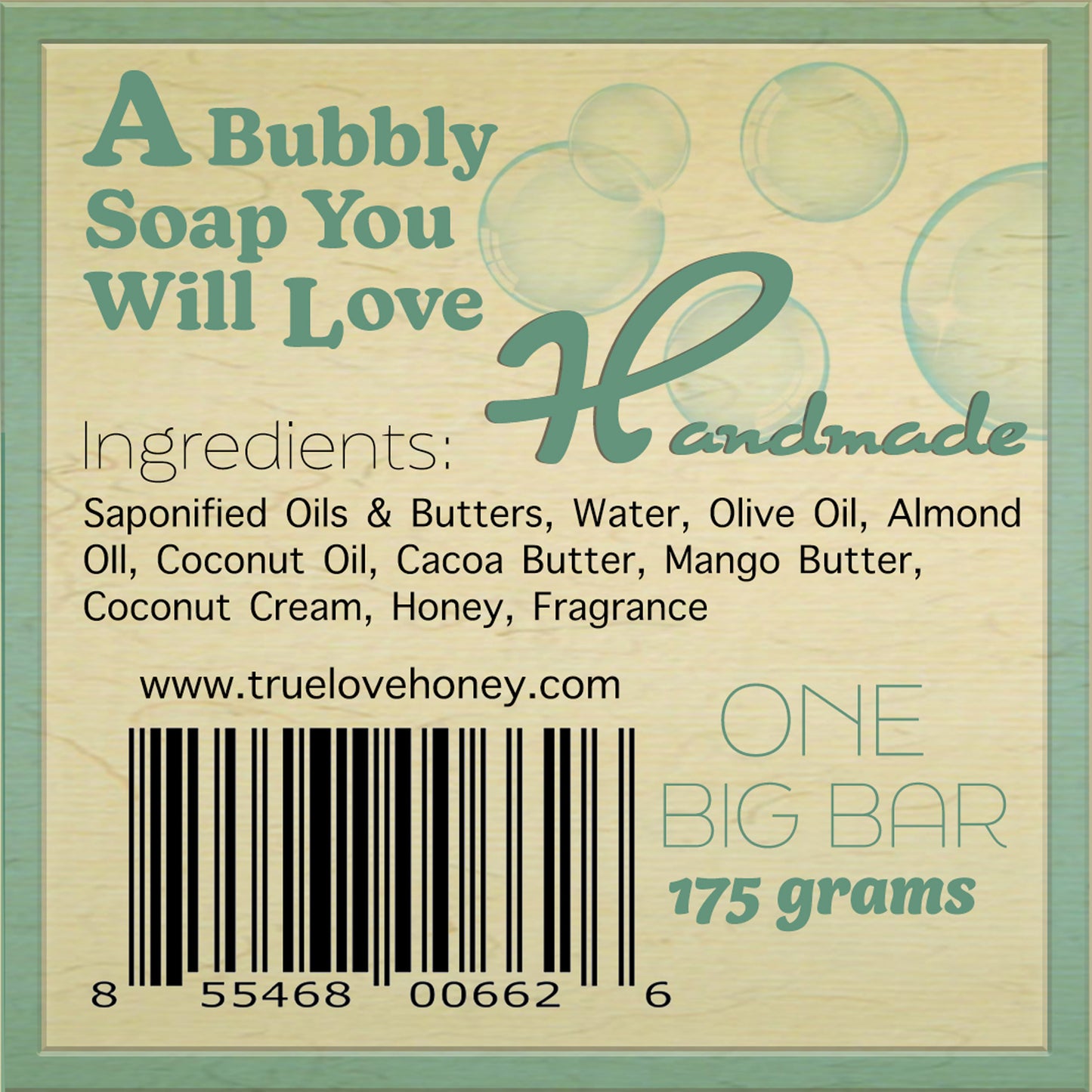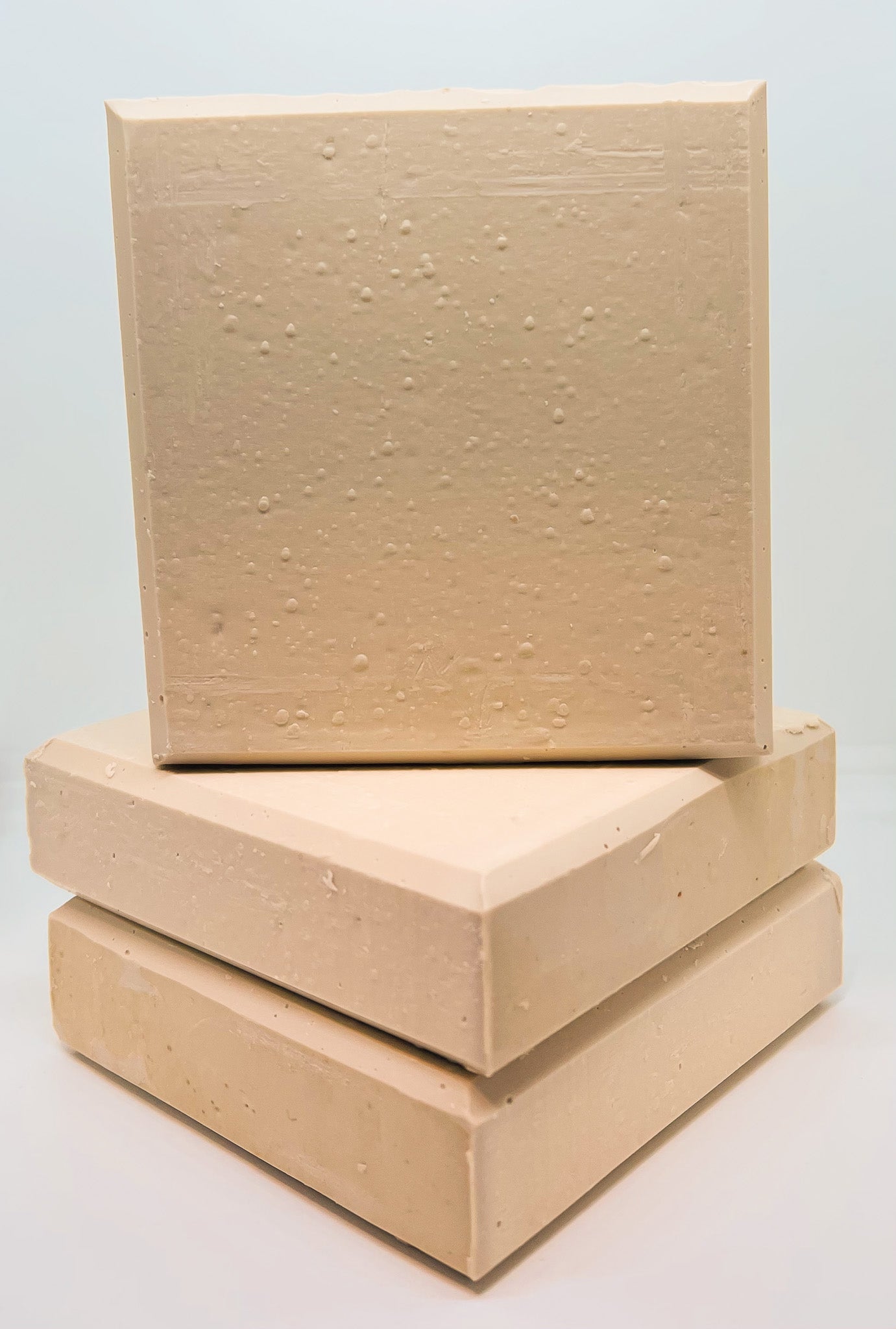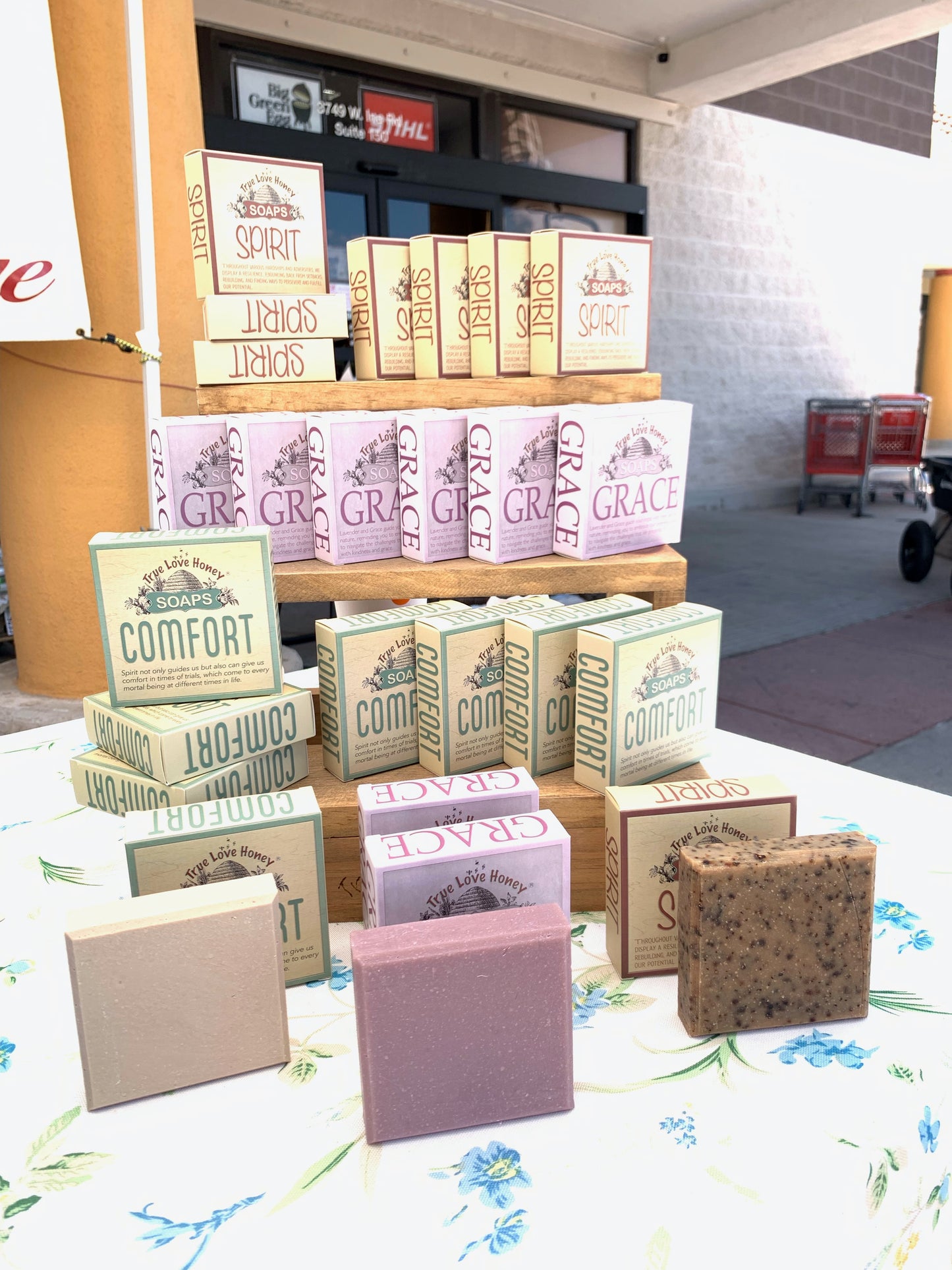True Love Honey
COMFORT SOAP BAR
COMFORT SOAP BAR
Ingredients
Ingredients
Saponified Oils and butters, Water, Olive Oil,Almond Oil, Coconut Oil,Cocoa Butter, Mango Butter, Coconut cream, Honey, and this bar has a light scent of Tobacco Vanilla.
Description
Description
Let's dive into some detail about the benefits of each ingredient in these soaps:
- Water: Water is the base of any soap and helps to create a lathering effect that aids in the cleansing process.
- Olive Oil: Olive oil makes a hard, long lasting soap with a gentle cleansing lather, suitable for all skin types including sensitive skins. High in Oleic acid, a soap made with olive oil will help to condition and soften your skin.
- Almond Oil: Almond oil is rich in vitamin E, which is a potent antioxidant that helps nourish and protect the skin. It can improve skin complexion, reduce dryness, and provide a soft and supple feel to the skin.
- Coconut Oil: Coconut oil is a highly moisturizing ingredient that helps lock in moisture and prevent moisture loss from the skin. It is rich in fatty acids, which provide hydration, promote a healthy skin barrier, and give the soap a creamy lather.
- Cocoa Butter: Cocoa butter is a luxurious moisturizer that deeply hydrates the skin. It is rich in antioxidants that help combat free radicals, improve skin elasticity, and promote a smoother, more youthful appearance.
- Mango Butter: Mango butter is derived from the kernels of the mango fruit. It is a rich emollient that helps moisturize and soften the skin. It can also help soothe and heal dry or irritated skin.
- Coconut Cream: Coconut cream is made from the flesh of mature coconuts and contains healthy fats that nourish and hydrate the skin. It provides a creamy texture to the soap and contributes to its moisturizing properties.
- Honey: Honey is a natural humectant, meaning it attracts and retains moisture in the skin. It has antibacterial and antimicrobial properties, which can help cleanse and soothe the skin. Honey also contains antioxidants that promote skin health and radiance.
- Each bar is 3 X 3 X 1 inch 175gr
By combining these ingredients, the soap provides a balance of cleansing and moisturizing properties. It can effectively cleanse the skin while nourishing and hydrating it, leaving your skin feeling refreshed, soft, and smooth.
Couldn't load pickup availability
Share




What's in our Handmade Spirit soap anyway?
-
Olive Oil
Olive oil is commonly used in soapmaking for its moisturizing and skin-nourishing properties, as it contains natural fats and antioxidants that can help maintain skin's hydration and softness. Additionally, olive oil contributes to the creamy lather and overall quality of the soap, making it a popular choice for soap formulations.
-
Almond Oil
Almond oil is utilized in soapmaking for its emollient and skin-conditioning attributes, which can help soothe and moisturize the skin, making it particularly suitable for individuals with dry or sensitive skin. Its mild, nutty aroma can also enhance the soap's fragrance, offering a pleasant and luxurious bathing experience.
-
Coconut oil
Coconut oil is a common ingredient in soapmaking due to its ability to produce a rich and abundant lather that effectively cleanses the skin. Additionally, coconut oil contributes to soap's hardness and longevity, making it a stable and popular choice for soap formulations.
-
Cocoa Butter
Cocoa butter is used in soap for its moisturizing and skin-conditioning properties. It helps to hydrate the skin, leaving it soft and supple, and also adds a creamy texture to soap bars. Additionally, cocoa butter's natural cocoa scent can provide a delightful fragrance to the soap, enhancing the overall bathing experience.
-
Mango Butter
Mango butter is used in soap for its rich moisturizing and nourishing qualities. It helps to hydrate and soften the skin, making it a beneficial ingredient for soaps designed to provide extra moisture and care, particularly for dry or sensitive skin types. Mango butter also contributes to the soap's hardness and can enhance its lather, creating a more luxurious and effective cleansing experience.
-
Coconut Cream
Coconut cream is used in soap for several reasons. It adds a luxurious and creamy texture to the soap, which can make for a smoother and more moisturizing lather. Additionally, coconut cream contains natural fats that can help hydrate and condition the skin, making it a popular choice for soap formulations that aim to provide a rich and indulgent bathing experience.
-
Honey
Our Honey is used in our soap for its natural humectant properties, which means it attracts and retains moisture on the skin. This helps to keep the skin hydrated and can be especially beneficial for those with dry or sensitive skin. Honey also adds a subtle sweetness and luxurious feel to the soap, making it a popular choice for natural and moisturizing soap formulations.
-
Lye/sodium Hydroxide
Lye, also known as sodium hydroxide or potassium hydroxide, is a crucial ingredient in soapmaking because it facilitates the saponification process. During saponification, lye reacts with fats or oils (such as olive oil, coconut oil, etc.) to create soap and glycerin. While lye is caustic in its raw form and requires careful handling, it is essential for turning the oils and fats into soap molecules, ensuring that the final product is safe and effective for cleansing the skin. However, it's important to note that in the finished soap, there is no lye remaining, as it completely reacts with the other ingredients during the soapmaking process.
How to take care of your soap
To make your soap bars last longer, consider implementing the following tips:
- Keep them dry: After each use, place the soap on a well-drained soap dish or soap saver that allows excess water to drain away. Keeping the soap dry between uses helps prevent it from dissolving too quickly.
- Use a soap dish with proper drainage: A soap dish with good drainage ensures that water doesn't accumulate around the soap, extending its lifespan.
- Store unused soap properly: If you have multiple bars of soap, store the extras in a cool, dry place away from direct sunlight and humidity. Wrap them in wax paper or plastic wrap to prevent moisture from getting to them.
- Cut the soap into smaller pieces: Cutting the soap into smaller pieces reduces the surface area exposed to water during use, which can make the soap last longer. See our Bubble Bites.
- Rotate soap bars: If you have several bars of soap, rotate their use. This prevents one bar from sitting in a wet soap dish for an extended period, allowing it to dry thoroughly between uses.
- Choose hard, long-lasting soap: Some soap formulations are harder and longer-lasting than others. Look for soap bars that are specifically designed to be hard and durable like ours.
- Avoid leaving soap in a humid environment: High humidity can cause soap to soften and dissolve more quickly. Store soap away from steamy bathrooms or invest in a dehumidifier if needed.
- Use a soap saver bag or pouch: Soap saver bags or pouches can help you use up small soap scraps and make the most of your soap.
By following these tips, you can maximize the lifespan of your soap bars and enjoy them for a more extended period.

Did you Know?
From Ancient Rituals to Modern Science: The Fascinating History of Hand Washing.
Hand washing has become an ingrained practice in our daily lives, however, the act of cleansing our hands is not a recent phenomenon. In fact, the history of hand washing spans centuries and is deeply intertwined with cultural, religious, and scientific developments. Join us on a journey through time as we explore the intriguing story of hand washing and its transformation from a simple ritual to a crucial element of public health.
- Ancient Origins:
Hand washing can be traced back to ancient civilizations, where it was primarily associated with religious and ceremonial practices. In ancient Egypt, for example, hand washing was an essential part of religious rituals and symbolized purification. Similarly, ancient Greeks and Romans practiced hand washing before entering temples or attending public gatherings, considering it a sign of respect and cleanliness. - Medieval Era and Renaissance:
During the Middle Ages, hand washing lost its prominence as hygiene practices declined. However, in the 14th century, the bubonic plague, also known as the Black Death, ravaged Europe, leading to a renewed focus on cleanliness. Physicians like Ibn Sina (Avicenna) advocated for regular hand washing to prevent the spread of disease. This idea was further advanced during the Renaissance, when scholars like Andreas Vesalius emphasized the importance of hand hygiene in medical settings. - Ignaz Semmelweis and the Birth of Modern Hand Hygiene:
The 19th century witnessed a significant turning point in the history of hand washing with the work of Ignaz Semmelweis. A Hungarian physician, Semmelweis noticed the high mortality rate of women due to puerperal fever in maternity wards. Through meticulous observation, he discovered that hand washing with chlorinated lime solution drastically reduced infections. However, his findings were initially met with skepticism and resistance from the medical community. - The Germ Theory and the Role of Louis Pasteur:
The groundbreaking discoveries of Louis Pasteur and the establishment of the germ theory in the late 19th century revolutionized our understanding of disease transmission. Pasteur's work demonstrated the existence of microorganisms and their role in causing infections. This revelation further underscored the importance of hand washing as a means of preventing the spread of germs. - Hand Hygiene in Healthcare Settings:
The 20th century saw significant advancements in hand hygiene practices within healthcare settings. In 1847, Hungarian physician Semmelweis's work was validated by the pioneering work of British surgeon Joseph Lister, who introduced antiseptic techniques in surgical procedures. This marked a pivotal moment in preventing the transmission of infections and contributed to improved patient outcomes. - Hand Washing and Public Health:
The understanding of hand hygiene expanded beyond healthcare settings, becoming a cornerstone of public health initiatives. The introduction of soap and running water in households, coupled with public health campaigns emphasizing the importance of hand washing, significantly improved overall hygiene practices. - Hand Washing in the Modern Era:
Today, hand washing plays a critical role in preventing the transmission of germs using soap and water for at least 20 seconds or utilizing alcohol-based hand sanitizers when handwashing facilities are not available.
Conclusion:
The history of hand washing highlights its evolution from a religious and ceremonial ritual to a scientifically recognized practice crucial for public health. From ancient civilizations to modern times, the understanding of hand hygiene has grown, driven by medical advancements and the recognition of microorganisms' role in disease transmission. As we continue to navigate the challenges posed by infectious diseases, the simple act of hand washing remains one of the most effective tools we have to protect ourselves and others.



